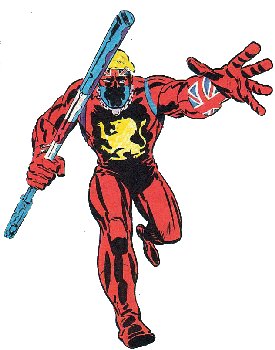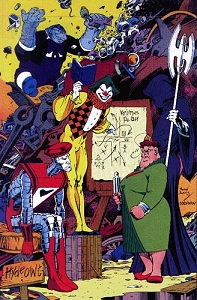BRITISH COMIC BLUES
Wed. March 17, 2004Categories: Abstract Dynamics

Another great post from Nick Gutterbreakz.
Nick’s commments on the difficulty of tracking down Marvel comics in the seventies are especially resonant for me. I echo absolutely what Nick says about the allure of the newsagents and the experience of discovering treasure troves of back issues in out-of-the-way seaside shops.
Britain in the seventies still felt like a wartime rationing culture. It wasn’t only the dominance of war comics (‘Die, Fritz! Aaaaarghhhhhhh’) that reinforced this impression; it was the sense of living in a monochrome outpost of the past. There’s a Robin Carmody-type analysis to be done of the Britcomics culture of masculine sporting and fighting prowess, with its association of Englishness with a turn-of-the-century Public School model of heroism. (This was doubled by the celebration of an innocent 1930s-vintage juvenile delinquency in kidcomics like the Beano and the Dandy). In any case, we accepted that living in Britain meant being mired in a historical backwater, that our culture was a threadbare, make-do shadow of America’s.
The UK Marvel reprints stood out from the other British comics because of their glossy covers, so I remember being heartbroken when, for some reason best known to themselves, UK Marvel reverted to paper covers. But even within the glossy covers, the Marvel UK comics were black and white. What more telling symbol of the relationship between British culture and American culture at the time could there be than the fact that our comics were black and white whereas America’s were, as Marvel proudly announced, ‘all-colour’?
In those days, long before comic shops were conceivable, especially in the nowheresville, Leicestershire where I lived, American comics were as rare and sporadic a presence as nylons in wartime. As a consequence, it was impossible to follow any story through. So the experience of reading the American Marvels was fragmentary and tantalizing: you knew when you breathlessly reached that cliffhanger panel (‘Next: The Abomination’) at the end of the issue that you would never manage to get hold of the next installment. Hence each issue was hoarded like cargo-culted debris, a window into an alien world. As Undercurrent’s banner commemorates, the advertisements were an integral element of the experience. The box of civil war soldiers, slimjims, hostess twinkies, life-sized Frankensteins, X-ray Specs, selling Grit: these products (forever denied us by the lack of a zip code), fanfared in the pages between the stories, became associated with Marvel’s mythworld.
re: my position on the UK comics contingent, I think some clarification is required. My problem with Moore et al wasn’t so much with their Marvel UK work; it’s the stuff they produced afterwards that I’m more ambivalent about.

Actually, it’s not quite true that Moore and Davis rescued Captain Britain. CB started off as a laughable disaster area for sure; the stories in the woefully disappointing Captain Britain Weekly were interesting only as an insight into American fantasies about Britain: red buses everywhere, blue-helmeted coppas, aristocrats living in stately piles, and a superficial smattering of Arthurian atmospherics. But when Captain Britain returned in Hulk Weekly, allied with the Black Knight and authored by a British creative team, it was much stronger. Captain Britain wasn’t an ersatz copy of an American hero any more; the authors interpolated him into a more densely-realised realm of Druidic myths. And when Captain Britain returned again, in the period immediately preceding Moore and Davis’ takeover, he was chaged once more. This time, CB’s world was derived from the twisted proto-anglopsychedelia of Lewis Carrol and the Avengers: a playing card, looking glass world full of bowler-hatted eccentrics and amiable psychotics. I was particularly fond of the Crazy Gang, for instance.

Where do (i) girls’ comics; (ii) 2000AD fit into your analysis?
>the Britcomics culture of masculine sporting and
>fighting prowess, with its association of
>Englishness with a turn-of-the-century Public
>School model of heroism.
cf Orwell’s essay on Magnet and other comix-precursors…
Where do (i) girls’ comics; (ii) 2000AD fit into your analysis?
Girls’ comics – nowhere. I’m shamefully ignorant of em.
2000 A.D. — not sure about this really. I had the first issue and must have bought it for about the first two years, but, interestingly, never kept them (a grotesque error in commercial terms, if in no other). I defintely regarded 2000 A.D. as being inferior to Marvel, less alluring, less mythically potent.
I believe you mean ALL-COLOR!, true believer.
The notion that UK comics still had to be about war continued into the 80s — a lot of us completely missed out on WARRIOR MAGAZINE, where Moore’s V FOR VENDETTA and MIRACLEMAN first appeared, simply because the comic’s name was so stale and unpromising.
It was the same deal in Trinidad. One issue of X-Men, part 7 of Secret Wars 2, TWO issues of Star Brand etc. etc. Some times a friend’s dad went to Miami and you might get a random bit of almost first hand America.
All color, of course!
a lot of us completely missed out on WARRIOR MAGAZINE, where Moore’s V FOR VENDETTA and MIRACLEMAN first appeared, simply because the comic’s name was so stale and unpromising
Fuk, yeh, Warrior, completely forgot about it! I think I’ve got every issue! Miracleman was called Marvelman back then, before Marvel jumped all over Warrior with hob-nailed boots. Warrior was fantastic, as I recall; but yeh, what a dreadful name.
btw you can see what the rundown of what was in each issue here (http://fourcolorheroes.home.insightbb.com/warrior1.html) and in subsequent pages.
Girls’ comics: http://www.savantmag.com/week6/essay6.html
The thing about the British reprints being All-Black&White isn’t quite correct: When Mighty World of Marvel was published, sections of it were in colour. However, for those of us who were already trawling every backstreet newsagent for American comics, this was even more depressing as the colour balance was all wrong, being much more garish then the US comics and spilling over the inking.
Incidentally, you could get (black and white) Marvel in British comics by the mid-sixties: It was licensed out. Spiderman, for example, was in a horrible comic called ‘Pow’. There was also a pure Marvel comic called ‘Fantastic’, containing X-Men, Iron Man, Thor, and some other stuff. It was this which generated the demand for American Marvel in the first place.
Anyhow, everybody knows that the best stuff being done in the 70’s was Jack Kirby’s work for DC…
Massive respect to Mark for correcting me on the Captain Britain thing. Yes, the Black Knight series that ran in Hulk Comic prior to that was a sensation. I still have them all stored away in a closet somewhere. The Parkhouse/Stokes partnership created a wonderfully magikal world, steeped in Arthurian legend. The early issues situated on desolate, mysterious Cornish coastlines are my favourites.
And fuck yeah, Warrior rocked my world to hell and back when it came out. That was all the cream of Marvel Uk talent rebelling against their tight-fisted US paymasters and striving out on their own. Ultimately, I think Marvel USA had the last laugh though when they took legal action over the use of the name “Marvelman” and buried Warrior. Bastards.